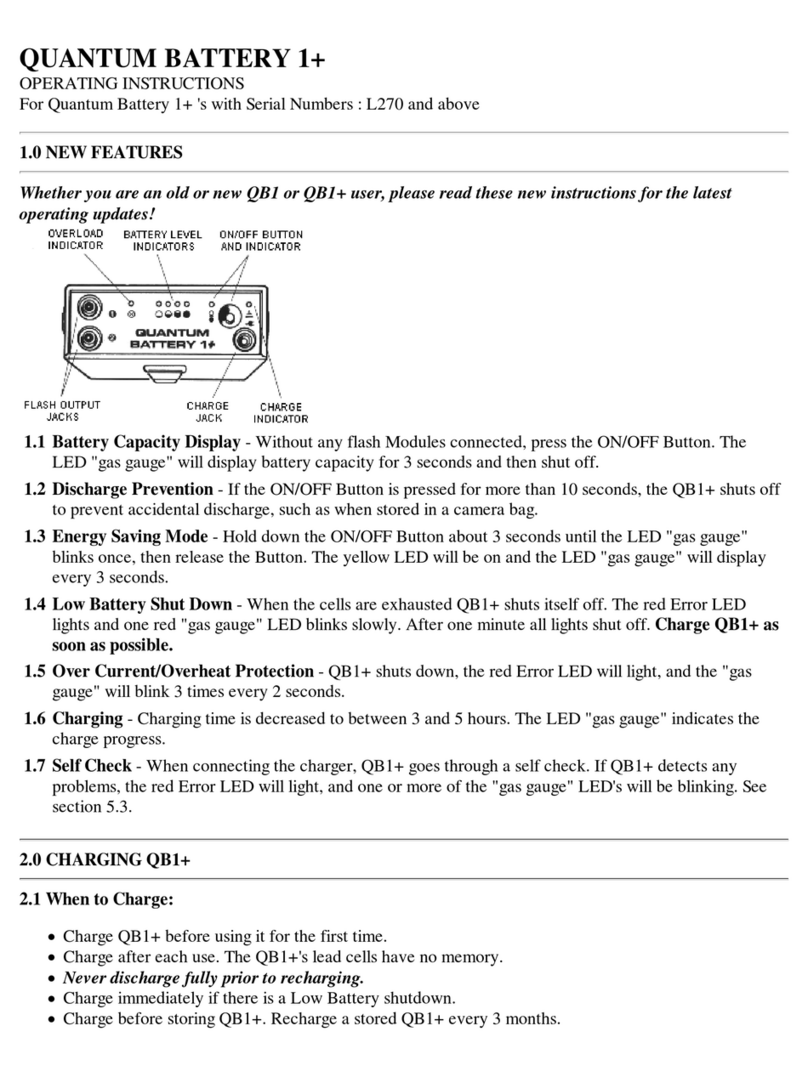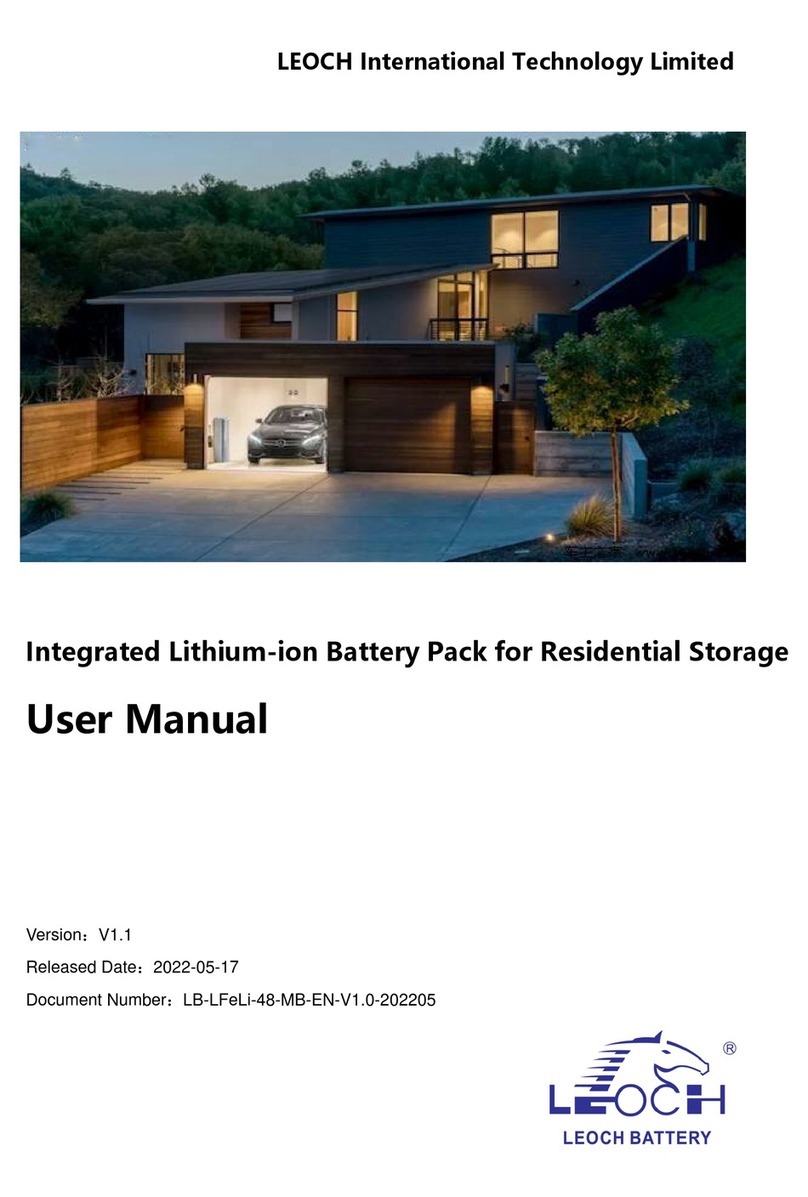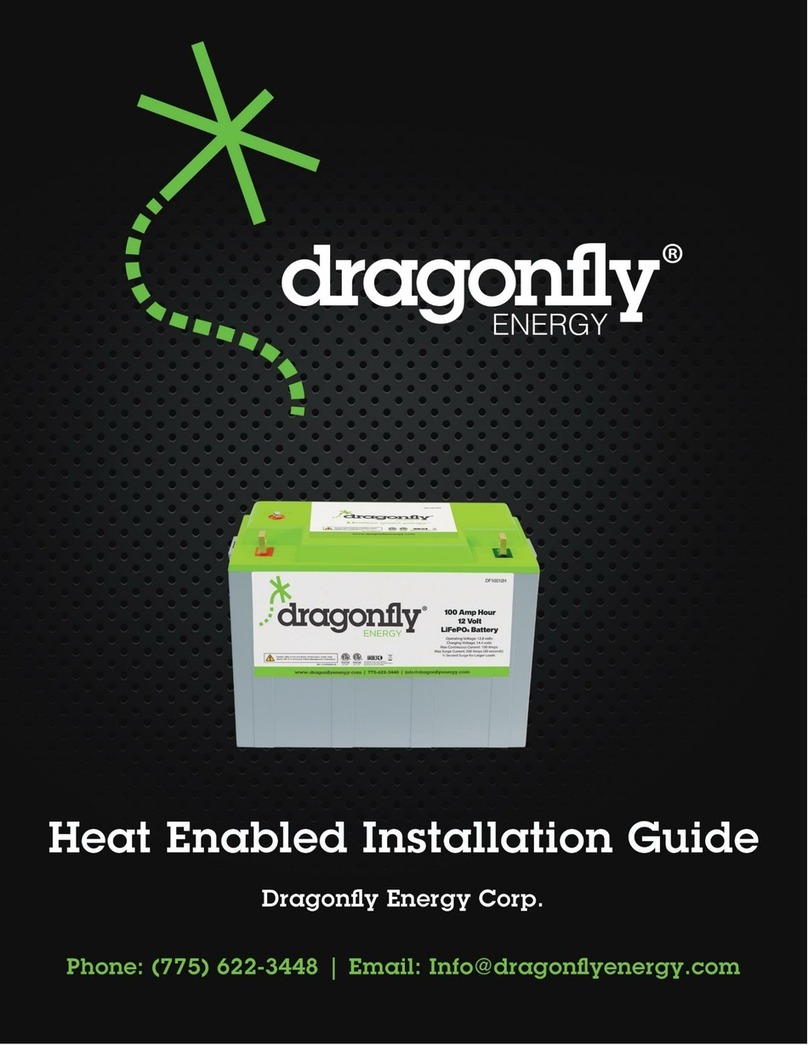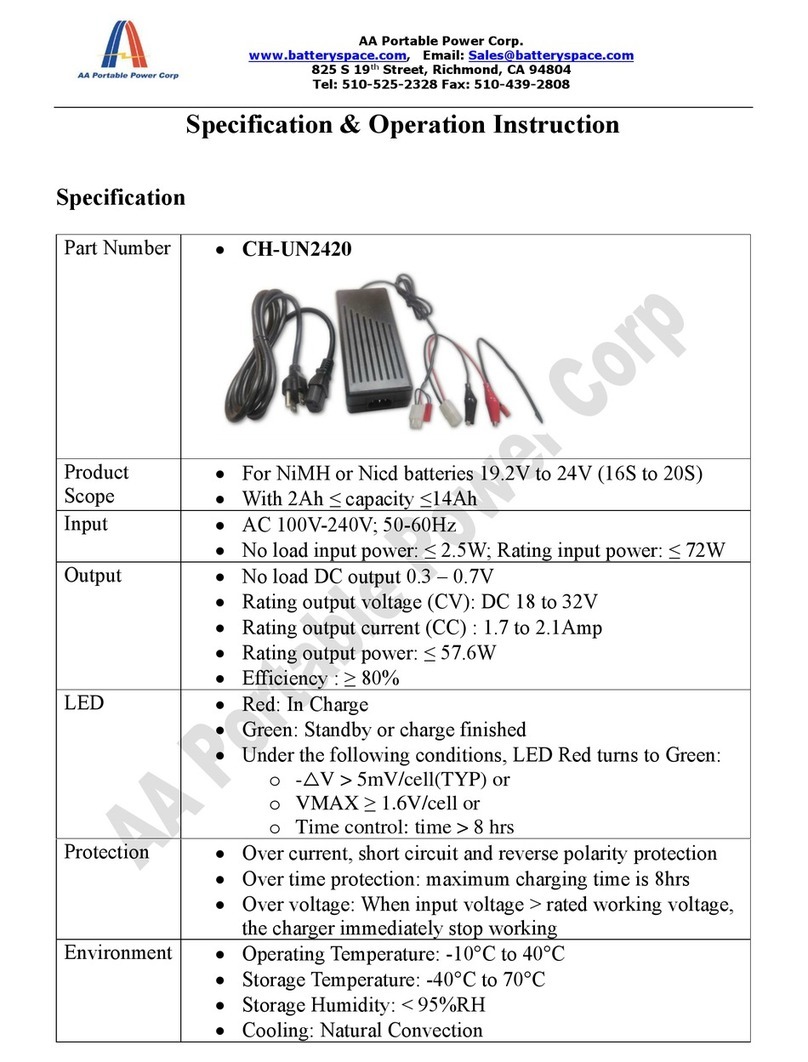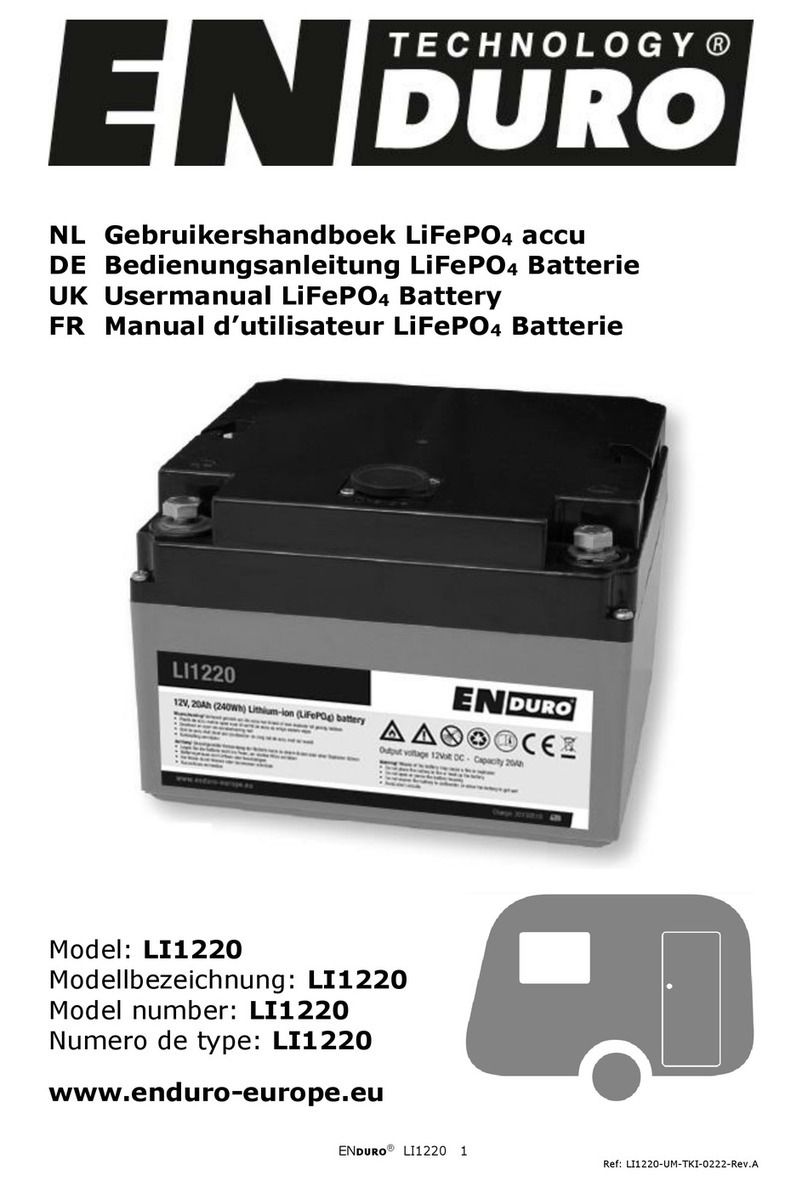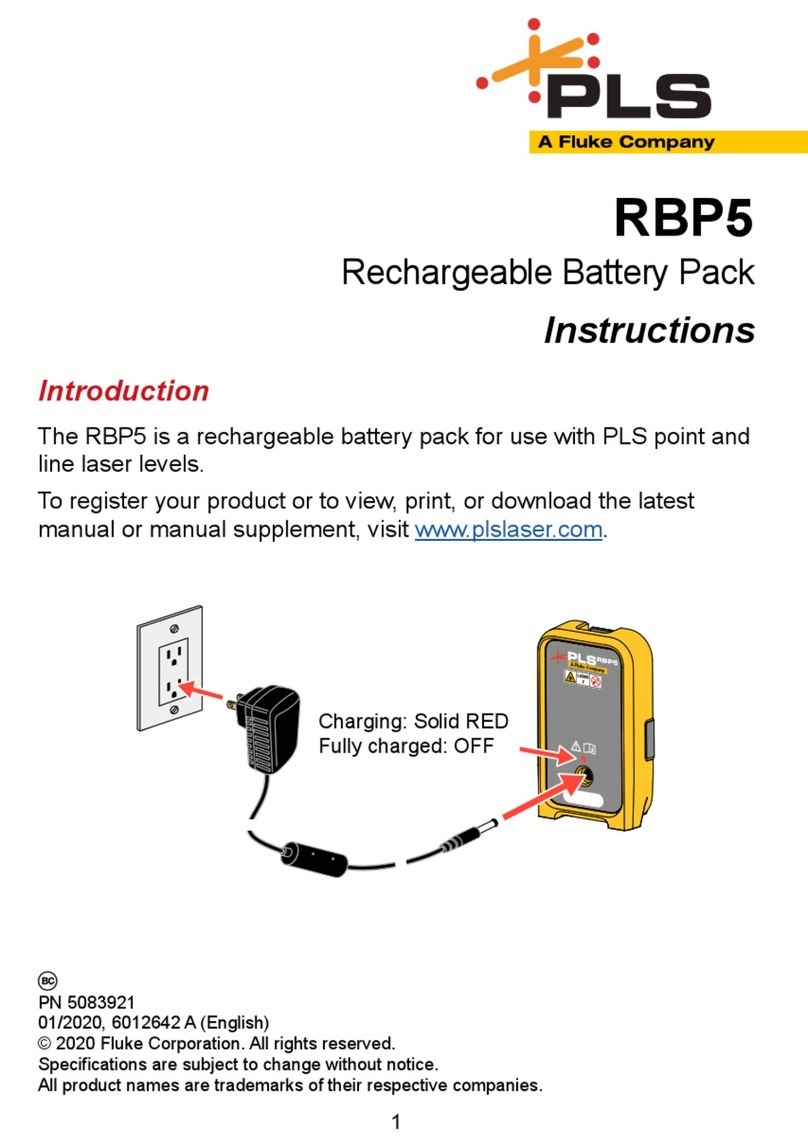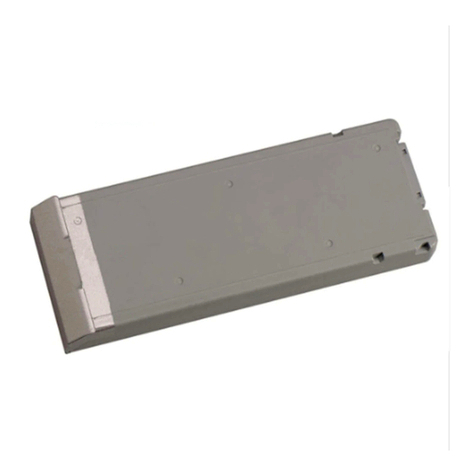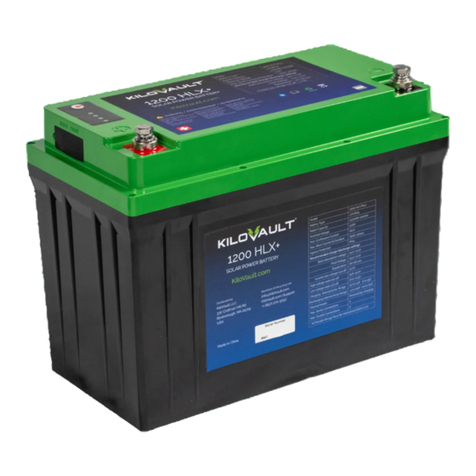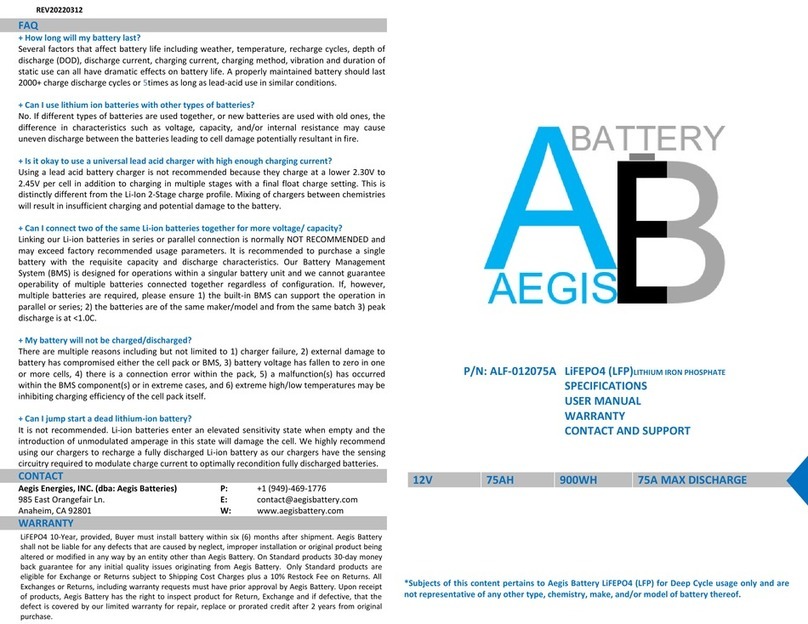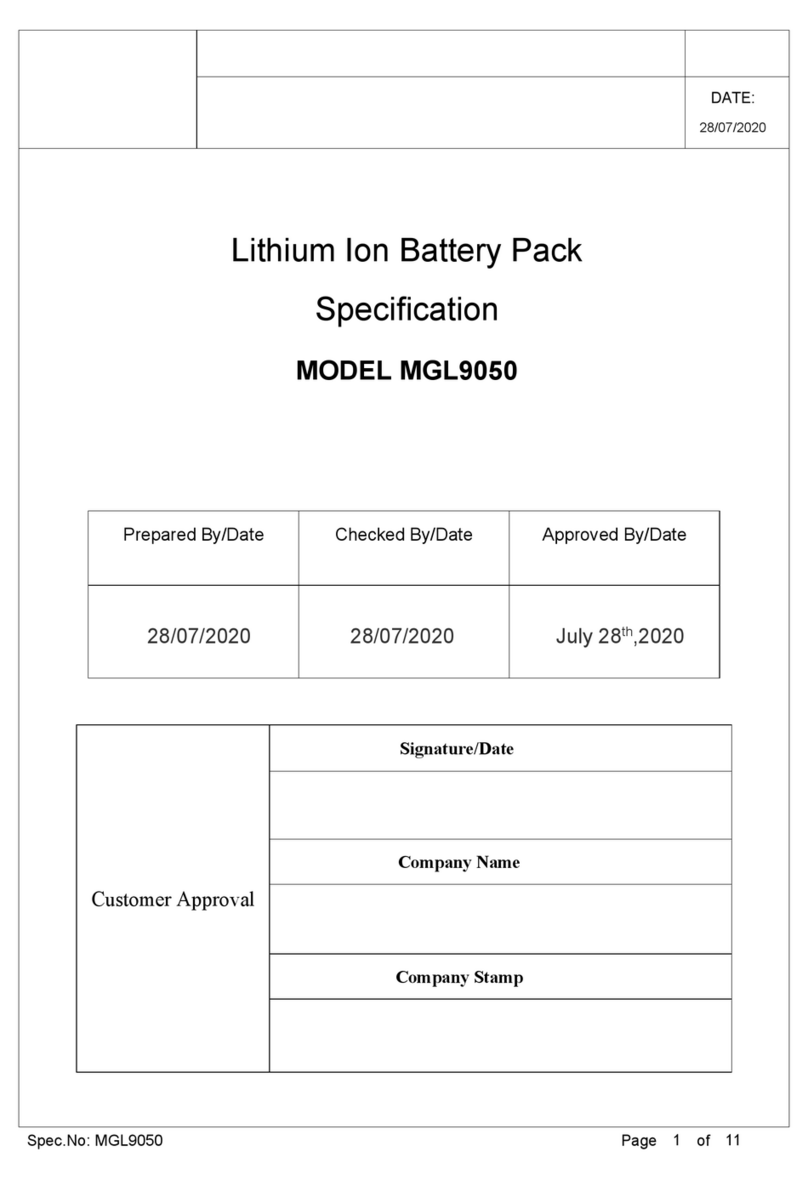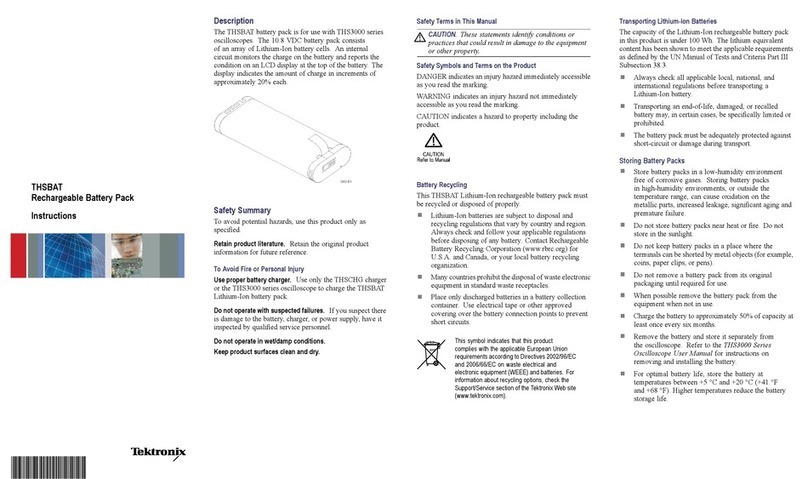Cramer 82V220G User manual

82V220G/ 82V430G/ 82C1G
(2905786/ 2905886/ 2905686)
EN | DE | ES | IT | FR | PT | NL | RU | FI || SV |
| NO|
| DA |
PL | CS | SK | SL| HR| HU | RO| BG| EL || AR |
| TR |
| HE |
LT | LV | ET |
cramer.eu

2
EN DE ES IT FR PT NL RU FI SV NO DA PL CS SK SL HR HU RO BG EL AR TR HE LT LV ET
English (Original Instructions)
BATTERY
SPECIFICATIONS
82V220G
Battery: 72V 3Ah, 216Wh, 82V MAX
Voltage per cell: 3.6V ; Number of cells: 20
Charge time: 45 min. (use 82C1G Charger)
82V430G
Battery: 72V 6Ah, 432Wh, 82V MAX
Voltage per cell: 3.6V ; Number of cells: 40
Charge time: 90 min. (use 82C1G Charger)
For the proper use, maintenance and storage
of this battery, it is crucially important that you
read and understand the instructions given in
this manual.
To avoid serious injury, risk of fire, explosion
and danger of electric shock or electrocution:
If the battery pack case is cracked or
damaged, DO NOT insert into the charger.
Replace with a new battery pack.
DO NOT charge these battery packs with
any other type of charger.
DO NOT try to short circuit any terminals
of battery pack.
WARNING
If the battery fluid gets in your eyes,
rinse immediately with clean water for
at least 15 minutes. Get immediate
medical attention. Do not charge the
battery pack in rain or in wet conditions.
Do not immerse the tool, battery pack,
or charger in water or other liquid.
Do not allow the battery pack or charger
to overheat. If they are warm, allow them
to cool down. Recharge only at room
temperature.
Do not place the battery pack in the sun
or in a warm environment. Keep at normal
room temperature.
Keep in shady, cool and dry condition, if
the battery is not charged for a long time;
charge the battery for 2 hours every 2
months.
The battery pack cells may develop a small
leak under extreme usage or temperature
conditions. If the outer seal is broken and
the leakage gets on your skin:
– Use soap and water to wash
immediately.
– Neutralize with lemon juice, vinegar, or
other mild acid.
If leakage gets in your eyes, follow
instructions above and seek medical
attention.
Please check prior use, if output voltage
and current of the battery charger is
suitable for the charging battery pack.
CHECKING BATTERY CAPACITY
Press the battery capacity indicator (BCI)
button. The lights will illuminate according to
the batteries capacity level. See chart below:
Lights
4 Green Lights he battery is above 80% capacity
3 Green Lights he battery is between 80% and 60% capacity
2 Green Lights he battery is between 60% and 40% capacity
1 Green Light The battery is between 40% and 25% capacity
Lights go out The battery is less than 25% capacity and
requires charging immediately
BATTERY CAPACITY
INDICATOR (BCI) BUTTON
LIGHT METER
Capacity
T
T
T
SAFETY NOTES AND PRECAUTIONS
1. Do not disassemble the battery.
2. Keep away from the children.
3. Do not expose the battery to water or salt
water, battery should be stored in a cool
and dry location and should place the
battery in cool and dry environment.
4. Do not place the battery in high-temperature
5. Do not reverse the positive terminal and
the negative terminal of the battery.
6. Do not connect the positive terminal and
the negative terminal of the battery to each
other with any metal objects.
7. Do not knock, strike or step on the battery.

3
English (Original Instructions)
EN DE ES IT FR PT NL RU FI SV NO DA PL CS SK SL HR HU RO BG EL AR TR HE LT LV ET
8. Do not solder directly onto the battery and
pierce the battery with nails or other edge
tools.
9. In the event that the battery leaks and the
eye. Rinse well with water. Immediately
discontinue use of the battery, if, while
using the battery emits an unusual smell,
feels hot, changes color, changes shape,
or appears abnormal in any other way.
BATTERY CHARGER
SPECIFICATIONS
82V Charger: 82C1G
Input: 230V 50/60Hz, 2.5A
Output: 82V 4A
DO NOT probe the charger with conductive
materials.
DO NOT allow liquid inside the charger.
DO NOT try to use the charger for any
other purpose than what is presented in
this manual.
Unplug the charger before cleaning and
when there is no battery pack in the
charger.
Do not try to connect two chargers
together.
Do notuse thecharger inthe circumstances
that the output Polarity does not match the
load polarity.
For indoor use only.
The cover may under no circumstances
be opened. If the cover is damaged, then
the charger may no longer be used.
Do not recharge non-rechargeable
batteries.
WARNING
To avoid risk of fire, electric shock, or
electrocution:
Do not use a damp cloth or detergent on
the battery or battery charger.
Always remove the battery pack before
cleaning, inspecting, or performing any
maintenance on the tool.
CLEANING
Wipe the outside of the charger with a dry,
soft cloth. Do not hose down or wash with
water.
Class II
For indoor use only
Before charging, read the
instructions
F8A Fuse
WARNING
This appliance can be used by children
aged from 8 years and above and
persons with reduced physical, sensory or
mental capabilities or lack of experience
and knowledge if they have been given
supervision or instruction concerning use of
the appliance in a safe way and understand
the hazards involved.
Children shall not play with the appliance.
Cleaning and user maintenance should not
be made by children without supervision.
If the supply cord is damaged,it must be
replaced by manufacturer, its service agent
or similarly qualified persons in order to
aviod a hazard.
Do not cover the ventilation slots on the top
of the charger. Do not set the charger on
a soft surface i.e. blanket, pillow. Keep the
ventilation slots of the charger clear.
Do not allow small metal items or material
such as steel wool, aluminum foil, or other
foreign particles into the charger cavity.
Use only 82V220G/82V430G rechargeable
Li-ion batteries.

4
English (Original Instructions)
EN DE ES IT FR PT NL RU FI SV NO DA PL CS SK SL HR HU RO BG EL AR TR HE LT LV ET
1
3
2
This is a diagnostic charger. The Charger
to communicate the current battery status.
They are as follows:
LED STATUS DESCRIPTION
Blinking Green Charging
Solid Green Fully Charged
Solid Red Over Temperature
Blinking Red Charging Fault
False Defect Note:
When the battery is inserted into the charger,
battery from the charger for 1 minute, then
reinsert. If the status LED indicates normal
than the battery pack is good. If the status
LED is still blinking, remove the battery pack
and unplug the charger. Wait 1 minute and
plug the charger back in and reinsert the
battery pack. If the status LED indicates
normal than the battery pack is good. If the
status LED is still blinking then the battery
pack is defective and needs to be replaced.
NOTE: When the red indictor ickers, pull out
the battery from the charger and insert again
within 2 hours. If the indictor shows charging,
that means the battery is good. After 2 hours,
please pull out the battery and also pull
out the AC power plug of the charger for 1
miniute, and then insert the AC power plug
and the battery again. If the indictor shows
charging, that means the battery is good. If
not, the battery needs to be changed.
ENVIRONMENTALLY SAFE BATTERY
DISPOSAL
WARNING
If the battery pack cracks or breaks, with
or without leaks, do not recharge it and do
not use. Dispose of it and replace with a
new battery pack. DO NOT ATTEMPT TO
REPAIR IT!
or electric shock, and to avoid damage to
the environment:
Cover the battery's terminals with heavy-
duty adhesive tape.
DO NOT attempt to remove or destroy
any of the battery pack components.
DO NOT attempt to open the battery
pack.
WARNING
If a leak develops, the released
electrolytes are corrosive and toxic. DO
NOT get the solution in the eyes or on
skin, and do not swallow it.
DO NOT place these batteries in your
regular household trash.
DO NOT incinerate.
DO NOT place them where they will
become part of any waste landfill or
municipal solid waste stream.
Take them to a certified recycling or
disposal centre.
CHARGING PROCEDURE
NOTE: The battery is not shipped fully
charged. It is recommended to fully charge
before use to ensure that maximum run time
can be achieved. This lithium-ion battery will
not develop a memory and may be charged
at any time.
1. Plug the charger into an AC power outlet.
2. Insert the battery pack (1) into the charger
(2).

5
English (Original Instructions)
EN DE ES IT FR PT NL RU FI SV NO DA PL CS SK SL HR HU RO BG EL AR TR HE LT LV ET
CHECKING THE CHARGER
If the battery pack does not charge properly:
Check the current at the power outlet with
another tool. Make sure that the outlet is
not turned off.
Check that the charger contacts have not
been shorted by debris or foreign material.
If the surrounding air temperature is not
normal room temperature, move the
charger and battery pack to a location
WARNING
If the battery is inserted into the charger
when warm or hot, the CHARGING LED
indicator light on the charger may switch
on and illuminate RED. If this occurs allow
the battery to cool outside of the charger
for approximately 30 minutes.
CHARGER MOUNTING
1. This charger can be installed hanging on a
wall using two screws (not supplied).
2. Locate the placement for the charger to be
wall mounted.
3. If fastening to wood studs use 2 wood
screws.
4. Drill two holes on center 114.3mm apart
ensuring that they are vertically aligned.
5. If fastening to drywall use wall anchors and
screws to secure the charger to the wall.
NOTE: If the battery and the charger won’t
be used for a long time, please remove the
battery from the charger and pull out the AC
power plug.
DETACHABLE POWER CORD
The power cords of the charger are
detachable. They can be removed from the
charger and used interchangeably. (See the
①②
③④
IMPORTANT SAFETY INSTRUCTIONS
1. SAVE THESE INSTRUCTIONS -
DANGER: TO REDUCE RISK OF FIRE
OR ELECTRIC SHOCK CAREFULLY
FOLLOW THESE INSTRUCTIONS.
2. Confirm the voltage available at each
country location before using the charger.
3. If the shape of the plug does not fit the
power outlet, use an attachment plug
adaptor of the proper configuration for the
power outlet.
CORRECT DISPOSAL OF THIS PRODUCT:
This marking indicates that this product should
not be disposed with other household wastes
throughout the EU. To prevent possible
harm to the environment or human health
from uncontrolled waste disposal, recycle it
responsibly to promote the sustainable reuse
of material resources. To return your used
device, please use the return and collection
systems or contact the retailer where the

6
English (Original Instructions)
EN DE ES IT FR PT NL RU FI SV NO DA PL CS SK SL HR HU RO BG EL AR TR HE LT LV ET
product was purchased. They can take this
product for environmental safe recycling.
REMOVAL OF WASTE BATTERIES AND
ACCUMULATORS
Li-ion
Member States shall ensure that
manufacturers design appliances in such a
way that waste batteries and accumulators
can be readily removed. Where they cannot
be readily removed by the end-user. Member
States shall ensure that manufacturers design
appliances in such a way that waste batteries
and accumulators can be readily removed by
of the manufacturer. Appliances in which
batteries and accumulators are incorporated
shall be accompanied by instructions on
how those batteries and accumulators can
be safely removed by either the end-user
Where appropriate, the instructions shall also
inform the end-user of the types of battery or
accumulator incorporated into the appliance.

EN DE
ES IT FR PT NL RU FI SV NO DA PL CS SK SL HR HU RO BG EL AR TR HE LT LV ET
7
Deutsch(Übersetzung der originalen Anleitungen)
AKKU
SPEZIFIKATIONEN
82V220G
Batterie: 72V 3Ah, 216Wh, 82V Maxi
Spannung pro Zelle: 3.6V; Anzahl der Zellen: 20
Ladezeit: 45 Min. (Benutzen Sie Ladegerät
82C1G)
82V430G
Batterie: 72V 6Ah, 432Wh, 82V Maxi
Spannung pro Zelle: 3.6V; Anzahl der Zellen: 40
Ladezeit: 90 Min. (Benutzen Sie Ladegerät
82C1G)
Für die richtigen Benutzung und Lagerung
dieses Akkus ist es von entscheidender
Wichtigkeit, dass Sie die Anweisungen
in dieser Bedienungsanleitung lesen und
verstehen.
Zur Vermeidung schwerer Verletzungen,
Feuer, Explosionen und Stromschlag:
Stecken Sie den Akkupack NICHT in
das Ladegerät, wenn er gerissen oder
beschädigt ist. Mit einem neuen Akkupack
ersetzen.
Laden Sie diese Akkus NICHT mit einem
anderen Ladegerät.
Versuchen Sie NICHT die Kontakte des
Akkupacks kurz zu schließen.
WARNUNG
Wenn Batterieflüssigkeit in Ihre Augen
gerät, spülen Sie sofort mit sauberem
Wasser für mindestens 15 Minuten.
Suchen Sie sofort medizinische Hilfe auf.
Laden Sie den Akkupack nicht im Regen
oder in nasser Umgebung. Tauchen Sie
das Werkzeug, den Akkupack oder das
Ladegerät nicht in Wasser oder eine
andere Flüssigkeit.
Lassen Sie den Akkupack oder das
Ladegerät nicht überhitzen. Wenn Sie
warm sind, lassen Sie sie abkühlen. Nur
bei Zimmertemperatur aufladen.
Setzen Sie den Akkupack nicht der Sonne
oder warmer Umgebung aus. Bei normaler
Zimmertemperatur halten.
Versuchen Sie nicht zwei Ladegeräte zu
verbinden.
Die Zellen des Akkupacks können bei
extremer Benutzung oder Temperaturen
kleine Lecks entwickeln. Wenn die äußere
Hülle beschädigt ist und die Flüssigkeit auf
Ihre Haut gerät:
– Waschen Sie sofort mit Seife und
Wasser.
– Mit Zitronensaft, Essig oder
einer anderen schwachen Säure
neutralisieren.
Wenn die Flüssigkeit in Ihre Augen
gelangt, befolgen Sie die oben genannten
Anweisungen und suchen medizinische
Hilfe auf.
Überprüfen Sie bitte vor der Benutzung,
ob Ausgangsspannung und Strom des
Ladagerätes zum Aufladen des Akkupacks
geeignet sind.
ÜBERPRÜFEN DER AKKUKAPAZITÄT
Drücken Sie die Taste für die Akkuanzeige
(BCI). Die Lampen leuchten gemäß dem
Ladezustand des Akkus auf. Sie Tabelle:
Lampen
4 Grüne Lampen
3 Grüne Lampen
2 Grüne Lampen
1 grüne Lampe Der Akku ist zwischen 40% und 25% aufgeladen
Lampen sind aus Der Akku ist unter 25% aufgeladen um muss
sofort neu aufgeladen werden
TASTE FÜR
AKKUKAPAZITÄTSANZEIGE (AKA)
LEUCHTANZEIGE
Kapazität
Der Akku ist zwischen 60% und 40% aufgeladen
Der Akku ist zwischen 80% und 60% aufgeladen
Der Akku ist zu mehr als 80% aufgeladen
SICHERHEITSGINWEISE UND
VORSICHTSMAßNAHMEN
1. Zerlegen Sie den Akku nicht.
2. Von Kindern fernhalten.
3. Setzen Sie den Akku nicht Wasser oder
Salzwasser aus, der Akku sollte an einem
kühlen und trockenen Ort aufbewahrt
werden.
4. Setzen Sie den Akku keinen hohen
Temperaturen aus, wie in der Nähe von
Feuer, Heizkörpern usw.
5. Vertauschen Sie nicht den positiven und

Deutsch(Übersetzung der originalen Anleitungen)
EN DE
ES IT FR PT NL RU FI SV NO DA PL CS SK SL HR HU RO BG EL AR TR HE LT LV ET
8
negativen Anschluss des Akkus.
6. Verbinden Sie den positiven und den
negativen Anschluss des Akkus nicht mit
einem Metallgegenstand.
7. Stoßen oder schlagen Sie den Akku nicht,
oder stellen sich darauf.
8. Löten Sie nichts an den Akku oder
durchbohren den Akku mit Nägeln oder
anderem spitzen Werkzeug.
9. Reiben Sie nicht das Auge, falls der Akku
undicht ist und Flüssigkeit in das Auge
gelangt ist. Gut mit Wasser spülen. Hören
Sie sofort mit der Benutzung des Akkus
auf, wenn der Akku bei der Benutzung
ungewöhnlich riecht, heiß wird, Farbe
oder Form ändert oder auf eine andere Art
ungewöhnlich aussieht.
AKKU-LADEGERÄT
TECHNISCHE DATEN
82V Ladegerät: 82C1G
Eingang: 230V 50/60Hz, 2.5A
Ausgang: 82V 4A
Stecken Sie KEINE elektrisch leitenden
Materialien in das Ladegerät.
Lassen Sie KEINE Flüssigkeit in das
Ladegerät eindringen.
Benutzen Sie das Ladegerät NICHT
für andere Aufgaben als die in dieser
Bedienungsanleitung genannten.
Ziehen Sie den Netzstecker des
Ladegerätes, bevor Sie es reinigen,
und wenn sich kein Akkupack in dem
Ladegerät befindet.
Schattig, kühl und trocken halten, wenn
der Akku für lange Zeit nicht benutzt wird;
laden Sie den Akku für 2 Stunden alle 2
Monate.
Benutzen Sie das Ladegerät nicht unter
Umständen wo die Ausgangspolarität
nicht zu der Spannungs-Polarität passt.
Nur für den Hausgebrauch.
Die Abdeckung darf unter keinen
Umständen geöffnet werden. Wenn
die Abdeckung beschädigt ist, darf das
Ladegerät nicht weiter benutzt werden.
Nicht zum Aufladen nicht-aufladbarer
Batterien.
WARNUNG
Zur Vermeidung von Feuer oder
Stromschlag:
Wenden Sie nicht ein feuchtes Tuch
oder Reinigungsmittel an dem Akku oder
Ladegerät an.
Entfernen Sie vor dem Reinigen,
Überprüfen oder Warten des Werkzeugs
immer den Akku.
REINIGUNG
mit einem weichen, trockenen Tuch. Nicht
abspritzen oder mit Wasser waschen.
Klasse II
Nur für den Innenbereich.
die Bedienungsanleitung.
F8A Sicherung
WARNUNG
Dieses Gerät darf von Kindern ab 8
Jahren und Personen mit verminderten
physischen, sensorischen oder geistigen
Fähigkeiten oder fehlender Erfahrung
und Wissen benutzt werden, wenn sie
beaufsichtigt werden oder über die sichere
Benutzung aufgeklärt wurden und die
damit verbundenen Gefahren verstehen.
Kinder dürfen nicht mit dem Gerät
spielen.
Reinigung und Wartung sollte nicht von
unbeaufsichtigten Kindern durchgeführt
werden.
Falls das Stromkabel beschädigt
ist, muss es zur Vermeidung einer
Gefährdung durch den Hersteller, dessen
Personen ausgetauscht werden.
Decken Sie die Ventilationsschlitze auf
der Oberseite des Ladegerätes nicht ab.
Stellen Sie das Ladegerät nicht auf einen
weichen Untergrund, z.B. Decke, Kissen.
Halten Sie die Ventilationsschlitze des
Ladegerätes frei.
Lassen Sie keine kleine Metallteile oder
Materialien wie Stahlwolle, Aluminiumfolie
oder andere Fremdkörper in das
Gehäuse des Ladegerätes gelangen.
Benutzen Sie nur 82V220G/82V430G Li-
Ionen Akkus.

Deutsch(Übersetzung der originalen Anleitungen)
EN DE
ES IT FR PT NL RU FI SV NO DA PL CS SK SL HR HU RO BG EL AR TR HE LT LV ET
9
1
3
2
Das ist ein Diagnose-Ladegerät. Die LED
Lampen des Ladegerätes (3) leuchten in
einer bestimmten Reihenfolge auf, um den
aktuellen Akkuzustand anzuzeigen. Sie sind
wie folgt:
LED-STATUS BESCHREIBUNG
Grün blinkend Aufladen
Grün Voll aufgeladen
Rot Überhitzung
Rot blinkend Ladefehler
Falsche Defektanzeige:
Wenn der Akku in das Ladegerät eingelegt
wird und die LED blinkt, entfernen Sie
den Akku für ungefähr 1 Minute aus dem
Ladegerät und legen ihn dann wieder ein.
Wenn die LED den Normalzustand anzeigt ist
der Akku in Ordnung. Wenn die LED immer
noch blinkt, entfernen Sie den Akkupack und
ziehen den Netzstecker des Ladegerätes.
Warten Sie 1 Minute und schließen das
Ladegerät wieder an und legen den Akku ein.
Wenn die LED den Normalzustand anzeigt ist
der Akku in Ordnung. Wenn die LED immer
noch blinkt, ist der Akkupack defekt und muss
ersetzt werden.
HINWEIS: Wenn die rote Anzeige ackert,
nehmen Sie den Akku aus dem Ladegerät
und legen ihn innerhalb von 2 Stunden wieder
ein. Wenn die Anzeige den Ladevorgang
anzeigt, ist der Akku in Ordnung. Nehmen Sie
nach 2 Stunden bitte den Akku heraus und
ziehen den Netzstecker für 1 Minute, legen
Sie dann den Akku wieder ein und schließen
UMWELTGERECHTE ENTSORGUNG
DER AKKUS
WARNUNG
Wenn der Akkupack reißt oder zerbricht,
mit oder ohne Leckage, laden Sie ihn nicht
auf und benutzen ihn nicht. Entsorgen
Sie es und ersetzen es mit einem neuen
Akkupack. VERSUCHEN SIE NICHT IHN
ZU REPARIEREN!
Zur Vermeidung von Feuer, Explosion
oder Stromschlag und Umweltschäden:
Decken Sie die Kontakte des Akkus mit
dickem Klebeband ab.
Versuchen Sie NICHT Teile des
Akkupacks zu entfernen oder zu
zerstören.
Versuchen Sie NICHT den Akkupack zu
öffnen.
WARNUNG
Wenn ein Leck auftritt, können die
austretenden Elektrolyte ätzend und giftig
sein. Lassen Sie die Lösung NICHT in
Ihre Augen oder auf Ihre Haut gelangen
und schlucken Sie sie nicht.
Geben Sie diese Akkus NICHT in den
normalen Haushaltsabfall .
NICHT verbrennen.
NICHT dort platzieren, wo sie in eine
Mülldeponie oder die Entsorgung von
Haushaltsabfall gelangen können.
Bringen Sie sie zu einem zugelassenen
Recycling- oder Entsorgungscenter.
LADEVORGANG
HINWEIS: Der Akku wird nicht voll geladen
verschickt. Es wird empfohlen den Akku
vor der Benutzung voll aufzuladen, um die
maximale Laufzeit zu erreichen. Dieser
Lithium-Ionen Akku entwickelt keinen
Memory-Effekt und kann jederzeit aufgeladen
werden.
1. Stecken Sie das Ladegerät in eine
Wechselstrom-Steckdose
2. Legen Sie den Akkupack (1) in das
Ladegerät (2).

Deutsch(Übersetzung der originalen Anleitungen)
EN DE
ES IT FR PT NL RU FI SV NO DA PL CS SK SL HR HU RO BG EL AR TR HE LT LV ET
10
das Ladegerät an das Stromnetz an. Wenn
die Anzeige den Ladevorgang anzeigt, ist der
Akku in Ordnung. Wenn nicht, muss der Akku
gewechselt werden.
ÜBERPRÜFEN DES LADUNG
Überprüfen Sie den Strom der Steckdose
mit einem anderen Werkzeug. Stellen
Sie sicher, dass die Steckdose nicht
ausgeschaltet ist.
Überprüfen Sie, dass die Ladekontakte
nicht durch Schmutz oder Fremdkörper
kurzgeschlossen sind.
Wenn die Umgebungstemperatur nicht die
normale Zimmertemperatur ist, bringen Sie
das Ladegerät und den Akkupack an einen
WARNUNG
Wenn der warme oder heiße Akku in das
Ladegerät eingelegt wird, leuchtet die
LADEN LED an dem Ladegerät ROT.
Wenn das passiert, lassen Sie den Akku
ohne das Ladegerät für ungefähr 30
Minuten abkühlen.
BEFESTIGUNG DES LADEGERÄTES
1. Dieses Ladegerät kann mit zweiv
Schrauben (nicht mitgeliefert) an eine
Wand montiert werden
2. Legen Sie den Ort für die Montage des
Ladegerätes fest.
3. Benutzen Sie 2 Holzschrauben, wenn sie
es an Holz befestigen.
4. Bohren Sie zwei Löcher 114.3 mm
auseinander und stellen Sie sicher, dass
sie in einer senkrechten Linie sind.
5. Benutzen Sie bei Montage an einer
Trockenwand Maueranker und Schrauben
zum Befestigen des Ladegerätes an die
Wand.
HINWEIS: Wenn der Akku und das Ladegerät
für lange Ziet nicht benutzt werden, entfernen
Sie bitte den Akku von dem Ladegerät und
ziehen den Netzstecker.
ABNEHMBARES NETZKABEL
Die Netzkabel des Ladegerätes sind
abnehmbar. Sie können von dem Ladegerät
entfernt und abwechselnd benutzt werden.
(siehe Abbildungen unten)
①②
③④
WICHTIGE SICHERHEITSANWEISUNGEN
1.HEBEN SIE DIESE ANWEISUNGEN
AUF - GEFAHR: BEFOLGEN SIE DIESE
ANWEISUNGEN, UM DIE GEFAHR
VON FEUER ODER STROMSCHLAG
ZU VERRINGERN.
2. Bestätigen Sie in jedem Land die
verfügbare Spannung, bevor Sie das
Ladegerät benutzen.
3. Wenn die Form des Steckers nicht in

Deutsch(Übersetzung der originalen Anleitungen)
EN DE
ES IT FR PT NL RU FI SV NO DA PL CS SK SL HR HU RO BG EL AR TR HE LT LV ET
11
den Stromanschluss passt, benutzen
Sie einen passenden Adapter für den
Stromanschluss.
RICHTIGE ENTSORGUNG DIESES
PRODUKTES:
Diese Markierung zeigt an, dass dieses
Produkt in der gesamten EU nicht zusammen
mit dem Haushaltsmüll entsorgt werden
darf. Um eine mögliche Schädigung der
Umwelt oder der menschlichen Gesundheit
durch unkontrollierte Entsorgung zu
vermeiden, recyceln Sie es verantwortlich
um eine nachhaltige Wiederverwendung
von Rohstoffen zu unterstützen. Um dieses
Gerät zurückzugeben, nutzen Sie bitte das
Rückgabe und Sammelsystem oder wenden
Sie sich an den Händler, bei dem Sie das
Produkt erworben haben. Der kann das
Produkt für ein umweltfreundliches Recycling
entgegennehmen.
ENTFERNEN VON BATTERIEN UND
AKKUS ZUR ENTSORGUNG
Li-ion
Mitgliedsstaaten stellen sicher, dass
Hersteller Gerät so entwickeln, dass Batterien
und Akkus einfach zur Entsorgung entfernt
werden können. Wo sie nicht einfach von
dem Endkunden entfernt werden können.
Mitgliedsstaaten stellensicher, dass Hersteller
Gerät so entwickeln, dass Batterien und
die unabhängig von dem Hersteller sind, zur
Entsorgung entfernt werden können. Geräte,
die Batterien und Akkus enthalten, werden
mit Anweisungen zur sicheren Entfernung
von Batterien und Akkus durch den
begleitet Gegebenenfalls informieren die
Anweisungen den Endverbraucher über die
Art der in dem Gerät enthaltenen Batterien
und Akkus.

EN DE
ES
IT FR PT NL RU FI SV NO DA PL CS SK SL HR HU RO BG EL AR TR HE LT LV ET
12
Español(Traducción de las instrucciones originales)
BATERÍA
SPECYFIKACJE
82V220G
Batería: 72V 3Ah, 216Wh, 82V Máx.
Voltaje por célula: 3.6V; Número de células: 20
Tiempo de precio: 45 minuto. (use 82C1G
Cargador)
82V430G
Batería: 72V 6Ah, 432Wh, 82V Máx.
Voltaje por célula: 3.6V; Número de células: 40
Tiempo de precio: 90 minuto. (use 82C1G
Cargador)
Para un uso, mantenimiento y
almacenamiento adecuados de la batería,
es sumamente importante que lea y entienda
las instrucciones incluidas en este manual.
Para evitar lesiones graves, riesgo de
incendio, explosión y peligro de descarga
eléctrica o electrocución:
Si el caso batería está roto o dañado, no
introduzca en el cargador. Reemplazar
con una batería nueva.
NO cargue las baterías con cualquier otro
tipo de cargador.
NO intente cortocircuitar los terminales de
la batería.
ADVERTENCIA
Si el líquido de la batería entra
en contacto con sus ojos, lávelos
inmediatamente con agua limpia durante
al menos 15 minutos. Busque atención
médica inmediata. No cargue la batería
a la lluvia o en condici nes húmedas.
No sumerja el instrumento, la atería o el
cargador en agua u otro líquido.
No permita que la batería o el cargador
se sobrecalienten. Si están calientes,
deje que se enfríen. Recargue sólo a
temperatura ambiente.
No coloque la batería al sol o en
un ambiente cálido. Manténgalos a
temperatura ambiente normal.
Mantener alejada de la luz directa, en un
lugar fresco y seco. Si la batería no se
ha cargado durante un periodo largo de
tiempo, cargue la batería durante 2 horas
cada 2 meses.
Las célulasde labatería puedendesarrollar
una pequeña fuga en condiciones
extremas de uso o de temperatura. Si la
junta exterior se rompe y la fuga entra en
contacto con la piel.
– Lávela de inmediato con agua y jabón.
– Neutralícela con zumo de limón,
vinagre u otro ácido suave.
Si una fuga de la batería entra en contacto
con sus ojos, siga las instrucciones
anteriores y busque atención médica.
Antes de usarlo, compruebe si la tensión
de salida y la corriente del cargador de la
batería son adecuadas para la batería de
carga.
COMPROBACIÓN DE LA PILA
Pulse el indicador de capacidad de la batería
(BCI). Las luces se encenderán según el
nivel de capacidad de las baterías. Consulte
la siguiente tabla:
Luces
4 Luces Verdes
3 Luces Verdes
2 Luces Verdes
1 Luz Verde La batería tiene entre un 40% y un 25% de capacidad
La batería está por debajo del 25% de su
capacidad y es necesario cargarla inmediatamente
CAPACIDAD DE LA
BATERÍA INDICADOR (BCI)
MEDIDOR DE LUZ
Capacidad
La batería tiene entre un 60% y un 40% de capacidad
La batería tiene entre un 80% y un 60% de capacidad
La batería más de un 80% de capacidad
Las luces se apagan
NOTAS Y PRECAUCIONES DE
SEGURIDAD
1. No desmonte la batería.
2. Mantenga la herramienta alejada de los
niños.
3. No exponga la batería al agua, dulce o
salada. La batería debe guardarse en un
lugar fresco y seco y debe colocarse en un
entorno fresco y seco.

Español(Traducción de las instrucciones originales)
EN DE
ES
IT FR PT NL RU FI SV NO DA PL CS SK SL HR HU RO BG EL AR TR HE LT LV ET
13
4. No coloque la batería en lugares con altas
temperaturas, como cerca de un fuego,
radiador, etc.
5. No invierta el terminal positivo y el terminal
negativo de la batería.
6. No conecte los terminales positivo y
negativo de la batería con objetos de metal.
7. No golpee ni pise la batería.
8. No realice soldaduras directamente en la
batería ni perfore la batería con clavos u
otras herramientas de corte.
9. En caso de que la batería presente fugas
y el líquido entre en el ojo, no se frote
los ojos. Enjuágue los bien con agua.
Suspenda inmediatamente el uso de la
batería si, durante el uso, la batería emite
un olor raro, se calienta, cambia de color,
cambia de forma o presenta cualquier otra
anomalía.
CARGADOR DE BATERÍA
ESPECIFICACIONES
82V cargador: 82C1G
Entrada: 230V 50/60Hz, 2.5A
Salida: 82V 4A
NO pruebe el cargador con materiales
conductores.
NO permita que entre líquido en el interior
del cargador.
NO intente usar el cargador para cualquier
propósito que no sea el presentado en
este manual.
Desenchufe el cargador antes de limpiarlo
y cuando no esté instalada la batería en
el cargador.
No intente conectar dos cargadores
juntos.
No utilice el cargador en circunstancias en
las que la polaridad de salida no coincida
con la polaridad de carga.
Sólo para uso en el interior.
La cubierta no debe abrirse bajo ninguna
circunstancia. Si la cubierta se daña, el
cargador no debe volver a utilizarse.
No intente recargar baterías recargables.
ADVERTENCIA
Para evitar riesgos de incendio, shock
eléctrico o electrocución:
No utilice tejidos humedos ni detergentes
que puedan entrar en contacto con la
bateria o con el cargador.
Retire siempre la bateria antes de
limpiar, inspeccionar o efectuar cualquier
operación de mantenimiento en la
herramienta.
LIMPIEZA
Limpie el exterior del cargador con un paño
mangueras.
Clase II
Para uso de interior sólo
Antes del cobro, lea la
instrucción.
F8A Fusible
ADVERTENCIA
Este aparato puede ser utilizado por niños
de 8 años o más y por personas con
discapacidad física, sensorial o mental
o falta de experiencia y conocimiento, si
se les ha supervisado o instruido acerca
del uso del aparato de manera segura y
comprenden los riesgos implicados.
· Los niños no deben jugar con el aparato.
· Los niños no deben realizar la limpieza y
mantenimiento de usuario sin supervisión.
· Si el cable de alimentación está dañado,
deberá ser reemplazado por el fabricante,
su agente de servicio o por personal
de peligro.
· Recargue sólo a temperatura ambiente.
· No cubra las ranuras de ventilación de la
parte superior del cargador. No coloque el
ejemplo, manta o almohada. Mantenga las
rejillas de ventilación del cargador libres
de obstáculos.
· Use solamente baterías recargables de
ion-litio 82V220G/82V430G.

Español(Traducción de las instrucciones originales)
EN DE
ES
IT FR PT NL RU FI SV NO DA PL CS SK SL HR HU RO BG EL AR TR HE LT LV ET
14
1
3
2
Este es un cargador con diagnóstico. Las
lámparas LED (3) del cargador se iluminan
indicar el estado actual de la batería. Ellos
son los siguientes.
ESTADO DEL
LED DESCRIPCIÓN
Verde parpadeante Carga
Verde fijo Carga completa
Rojo fijo Temperatura
excesiva
Rojo parpadeante Problema en la
carga
Nota de defecto falso:
Cuando la batería esté insertada en el
cargador yel LED deestado parpadee,retire la
batería del cargador durante 1 minuto y luego
vuelva a insertarla. Si el LED de estado i ndica
normal, la batería está en correcto estado. Si
el LED de estado sigue parpadeando, retire
la batería y desenchufe el cargador. Espere
1 minuto, vuelva a enchufar el cargador de
nuevo y, a continuación, reinserte la batería.
Si el LED de estado indica normal, la batería
está en correcto estado. Si el LED de estado
es defectuosa y necesita reemplazarse.
NOTA: Cuando el indicador rojo parpadee,
saque la batería del cargador e vuelva a
insertarla en el plazo de 2 horas. Si el indicador
indica que se está cargando, signica que la
batería está en correcto estado. Después
de 2 horas, retire la batería y desconecte el
enchufe de alimentación de CA del cargador
durante 1 minuto. A continuación, vuelva a
insertar el enchufe de alimentación de CA y
ELIMINACIÓN SEGURA DE LA BATERÍA
ADVERTENCIA
Si la batería se agrieta o se rompe, con
o sin escapes, no la recargue ni la utilice.
Deséchela y sustitúyala por una batería
nueva. ¡NO INTENTE REPARARLA!
Para evitar lesiones y riesgos de incendio,
explosión o shock eléctrico, así como
dañar el medio ambiente:
Cubra los terminales de la cubierta de la
batería con cinta adhesiva resistente.
NO intente retirar ni destruir
componentes de la batería.
NO intente abrir la batería.
ADVERTENCIA
Si aparece una grieta, los electrolitos que
se liberan son corrosivos y tóxicos. NO
permita que la solución entre en contacto
con los ojos o la piel y no la ingiera.
NO tire estas baterías a la basura.
NO las incinere.
NO las ponga donde puedan acabar en
el basurero o en una línea de tratamiento
de residuos municipal.
recogida de desechos.
PROCEDIMIENTO DE CARGA
NOTA: La batería no se envía completamente
cargada. Se recomienda cargarla
completamente antes de usarla por primera
vez para garantizar que se pueda obtener
el máximo tiempo de funcionamiento. Esta
batería de ión de litio no desarrolla memoria
y se le puede cargar en cualquier momento.
1. Enchufe el cargador en un tomacorriente
de CA.
2. Coloque el paquete de baterías (1) en el
cargador (2).

Español(Traducción de las instrucciones originales)
EN DE
ES
IT FR PT NL RU FI SV NO DA PL CS SK SL HR HU RO BG EL AR TR HE LT LV ET
15
la batería. Si el indicador indica que se está
cargando, signica que la batería está en
correcto estado. Si no, la batería necesita
reemplazarse.
COMPROBACIÓN DE LA CARGA
Si la batería no se recarga adecuadamente:
Compruebe la corriente de la toma con
otro aparato electrico. Asegúrese de que la
toma está encendida.
Compruebe que no haya residuos ni
elementos ex traños interfiriendo en las
conexiones del cargador.
Si la temeperatura ambiental no es una
temperatura normal, lleve el cargador y la
batería a unlugar con una temperatura de
entre 7ºC y 40ºC.
ADVERTENCIA
Si se inserta la batería en el cargador
estando caliente, se enciende la luz LED
del indicador de CARGA del cargador
y se pone ROJO. Si esto sucede, deje
enfriar la batería fuera del cargador
durante aproximadamente 30 minutos.
MONTAJE DEL CARGADOR
1. Este cargador se puede instalar en una
pared atornillándolo con dos tornillos (no
incluidos).
2. Localice el lugar en el que quiere co lgar el
cargador.
3. Si la pared es de madera, utilice dos tornillos
especiales para madera.
4. Perfore dos agujeros en el centro con
una distancia de 114.3 mm alineados
verticalmente.
5. Si la forma del enchufe no encaja en la
toma de corriente, utilice un adaptador con
la configuración apropiada para la toma de
corriente.
NOTA : Si no va a utilizar la batería y el
cargador durante un periodo largo de tiempo,
retire la batería del cargador y desenchufe el
cable de alimentación de CA.
CABLE DE ALIMENTACIÓN DESMONTABLE
Los cables de alimentación del cargador
son desmontables. Se pueden remover del
cargador y utilizar indistintamente. (Véase la
figura abajo)
①②
③④
INSTRUCCIONES DE SEGURIDAD
IMPORTANTES
1. GUARDE ESTAS INSTRUCCIONES
- PELIGRO PARA REDUCIR EL
RIESGO DE INCENDIO O DESCARGA
ELÉCTRICA, SIGA ATENTAMENTE
ESTAS INSTRUCCIONES.
2. Compruebe el voltaje disponible en cada
país antes de usar el cargador.
3. Si la forma del enchufe no encaja en la

Español(Traducción de las instrucciones originales)
EN DE
ES
IT FR PT NL RU FI SV NO DA PL CS SK SL HR HU RO BG EL AR TR HE LT LV ET
16
toma de corriente, utilice un adaptador con
la configuración apropiada para la toma de
corriente.
Esta marca indica que este producto no
debería ser dispuesto con otras basuras
de la casa en todas partes de la Unión
Europea. Para prevenir el daño posible al
ambiente o salud humana de la eliminación
de desperdicios incontrolada, recíclelo con
responsabilidad para promover la reutilización
sostenible de recursos materiales. Para
devolver su dispositivo usado, por favor
use los sistemas de colección y vuelta o
póngase en contacto con el detallista donde
el producto fue comprado. Ellos pueden
tomar este producto para el reciclaje seguro
ambiental.
ELIMINACIÓN DE BATERÍAS Y
ACUMULADORES USADOS
Li-ion
Los Estados miembros se asegurarán que
los fabricantes diseñarán aparatos, de tal
manera que los residuos de baterías y
acumuladores se pueden eliminar fácilmente.
Cuando no se pueden eliminar fácilmente
se asegurarán que los fabricantes diseñarán
aparatos, de tal manera que los residuos de
baterías y acumuladores se pueden eliminar
que son independientes de los fabricantes.
Aparatos en los que se incorporan baterías
y acumuladores deberán ir acompañados de
instrucciones sobre cómo estas baterías y
acumuladores se pueden eliminar de manera
En su caso, las instrucciones también
batería o acumulador incorporado en el
aparato.

EN DE ES IT
FR PT NL RU FI SV NO DA PL CS SK SL HR HU RO BG EL AR TR HE LT LV ET
17
Italiano(Traduzione dalle istruzioni originali)
BATTERIA
SPECIFICHE
82V220G
Batteria: 72V 3Ah, 216Wh, 82V Massimo
Voltaggio per cella: 3.6V; Numero di celle: 20
Tempo di carica: 45 min. (utilizzare un
caricatore 82C1G)
82V430G
Batteria: 72V 6Ah, 432Wh, 82V Massimo
Voltaggio per cella: 3.6V; Numero di celle: 40
Tempo di carica: 90 min. (utilizzare un
caricatore 82C1G)
Per un corretto utilizzo, manutenzione
e riponimento della batteria, leggere e
comprendere tutte le istruzioni nel presente
manuale.
Per evitare lesioni gravi, rischi d'incendio,
esplosioni e pericolo di gravi scosse elettriche:
Se la scatola del gruppo batterie è
rotta o danneggiata, NON inserire nel
caricatore. Sostituire con un nuovo
gruppo batterie.
NON caricare questi gruppi batteria con
un altro tipo di caricatore.
NON cercare di cortocircuitare i terminali
del gruppo batterie.
AVVERTENZE
Se il liquido della batteria entra neglio
occhi, lavarsi immediatamente con
acqua pulita per almeno 15 minuti.
Rivolgersi immediatamente a un medico.
Non ricaricare il gruppo batterie sotto
la pioggia o in condizioni umide. Non
immergere l'utensile, il gruppo batterie o
il caricatore in acqua o in altri liquidi.
Non permettere che il gruppo batterie
o il caricatore si surriscaldino. Se sono
caldi, lasciarli raffreddare. Ricaricare
solo a temperatura ambiente.
Non posizionare il gruppo batterie sotto
la luce diretta del sole o in un ambiente
caldo. Tenere sempre a temperatura
ambiente.
Se la batteria non verrà caricata per
un lungo periodo di tempo, conservarla
sempre all'ombra, al fresco e in luoghi
asciutti; charicare la batteria per 2 ore
ogni 2 mesi.
Le celle del gruppo batteria potranno
sviluppare piccole perdite se utilizzate
troppo o a temperature estreme. Se il
sigillo esterno si rompe e il liquido entra
in contatto con la pelle:
– Lavarsi immediatamente con acqua e
sapone.
– Neutralizzare con succo di limone,
aceto o altri acidi medi.
Se il liquido entra in contatto con gli
occhi, seguire le istruzioni di cui sopra e
rivolgersi a un medico.
Prima dell'utilizzo controllare che il
voltaggio in uscita e la corrente del
caricatore della batteria siano adatti per
caricare il gruppo batterie.
CONTROLLARE LA CAPACITÀ DELLA
BATTERIA
Premere il tasto indicatore di capacità
batteria (BCI - battery capacity indicator).
Le luci si accenderanno a seconda del
livello di capacità della batteria. Vedere lo
schema seguente:
Luci
4 luci verdi
3 luci verdi
2 luci verdi
1 luce verde La batteria ha una cari.
Le luci si
spengono
La batteria ha una carica inferiore al 25% e
richiede di essere ricaricata immediatamente.
(BATTERY CAPACITY INDICATOR - BCI)
MISURAZIONE
CARICA BATTERIA
Kapazität
La batteria ha una cari.
La batteria ha una cari.
La batteria ha una cari.
NOTE DI SICUREZZA E PRECAUZIONI
1. Non smontare la batteria.
2. Tenere lontano dai bambini.
3. Non esporre la batteria all'acqua o all'acqua
salata, riporla in un luogo e in un ambiente
fresco e asciutto.
4. Non posizionare la batteria in luoghi troppo
caldi, come accanto a un fuoco o a un
radiatore, ecc.
5. Non invertire i terminali negativo e positivo
della batteria.

Italiano(Traduzione dalle istruzioni originali)
EN DE ES IT
FR PT NL RU FI SV NO DA PL CS SK SL HR HU RO BG EL AR TR HE LT LV ET
18
6. Non collegare il terminale positivo e quello
negativo della batteria con altri oggetti metallici.
7. Non colpire, far cadere, nè camminare sulla
batteria.
8. Non svolgere operazioni di saldatura sulla
batteria, nè perforarla con chiodi o con altri
oggetti appuntiti.
9. Nel caso in cui la batteria perda liquidi
che entrano in contatto con gli occhi, non
utilizzare la batteria e se la batteria emette
odori inusuali, si surriscalda, cambia colore
o forma e ha un aspetto anormale, smettere
di utilizzarla.
CARICATORE BATTERIA
SPECIFICHE
Caricatore da 82V: 82C1G
Entrata: 230V 50/60Hz, 2.5A
Uscita: 82V 4A
NON sondare il caricatore con materiale
conduttivo.
Non lasciare che del liquido penetri all'interno
del caricatore.
NON tentare di utilizzare il caricatore per
scopi diversi da quelli indicati nel presente
manuale.
Scollegare il caricatore prima di pulirlo o
quando non c'è alcun gruppo batterie al suo
interno.
Non cercare di collegare assieme due
caricatori.
Non utilizzare il caricatore in circostanze in
cui la polarità in uscita non sia pari a quella
di carica.
Solo per uso in interni.
Non aprire in alcuna circostanza il coperchio.
Se il coperchio è danneggiato, il caricatore
potrà rompersi e non essere più utilizzato.
Non ricaricare le batterie non ricaricabili.
AVVERTENZE
Per evitare rischi d'incendio, o scosse e
scariche elettriche:
Non passare panni umidi o detergenti
sulla batteria o sul caricatore della batteria.
Rimuovere sempre il gruppo batterie
prima di pulire, ispezionare o svolgere le
operazioni di manutenzione sull'utensile.
PULIZIA
Pulire l'esterno del caricatore con un panno
eventuali pompe nè pulire con acqua.
Classe II
Solo per uso interno.
Prima di caricare leggere le
istruzioni
F8A Fusibile
AVVERTENZE
Questo dispositivo può essere utilizzato
da bambini dagli 8 anni in su e da persone
con ridotte capacità fisiche, sensoriali o
mentali o senza la necessaria esperienza
e conoscenza purchè abbiano ricevuto
le dovute istruzioni riguardanti l'utilizzo
del dispositivo in modo sicuro e abbiano
compreso i rischi impliciti
I bambini non devono giocare con il
dispositivo.
Le operazioni di manutenzione e pulizia
non dovranno essere svolte da bambini
non supervisionati.
Se il cavo dell'alimentazione è
danneggiato dovrà essere sostituito dalla
ditta produttrice, da un suo rappresentante
autorizzato o da persona ugualmente
Non coprire le griglie di ventilazione
sulla parte superiore del caricatore. Non
morbida come una coperta o un cuscino.
Tenere le griglie di ventilazione pulite.
Non lasciare che piccoli oggetti in metallo
o materiali come lana d'acciaio, fogli
d'alluminio o altre particelle estranee
entrino nelle cavità del caricatore.
Utilizzare solo batterie ricaricabili agli ioni
di litio 82V220G/82V430G .

Italiano(Traduzione dalle istruzioni originali)
EN DE ES IT
FR PT NL RU FI SV NO DA PL CS SK SL HR HU RO BG EL AR TR HE LT LV ET
19
1
3
2
Questo è un caricatore diagnostico. Le luci
al LED del caricatore (3) si illumineranno in
attuale della batteria. Carica della batteria a
seconda delle luci:
STATO LED DESCRIZIONE
Verde
lampeggiante In carica
Verde fisso Completamente
carico
Rosso fisso Temperatura troppo
alta
Rosso
lampeggiante Errore di carica
Luce indicante un falso difetto:
Quando la batteria viene inserita nel
caricatore, e il LED di stato lampeggia,
rimuovere la batteria dal caricatore per 1
minuto, quindi reinserirla. Se lo stato del
Led indica normale allora il gruppo batterie
è funzionante. Se il dispositivo di stato
del LED lampeggia ancora, rimuovere il
gruppo batterie e scollegare il caricatore.
Attendere 1 minuto e collegare di nuovo il
caricatore e reinserire il gruppo batterie. Se
il dispositivo di stato del LED indica normale
allora il gruppo batterie è funzionante. Se
il dispositivo di stato del LED lampeggia
ancora allora il gruppo batterie è difettoso
e deve essere sostituito.
NOTE: Quando l'indicatore rosso
lampeggia, estrarre la batteria dal
caricatore e reinserirla entro 2 ore. Se
l'indicatore mostra la carica, la batteria
SMALTIMENTO ECO-COMPATIBILE
DELLA BATTERIA
AVVERTENZE
Se il gruppo batterie si rompe o cade,
con o senza perdita di liquidi, non
ricaricarlo e non utilizzarlo. Smaltirlo e
sostituirlo con un nuovo gruppo batterie.
NON TENTARE DI RIPARARLO!
Per evitare lesioni e rischi d'incendio,
esplosioni o scosse elettriche ed evitare
di arrecare danni all'ambiente:
Coprire i terminali della batteria con
nastro adesivo resistente.
NON tentare di rimuovere o distruggere i
componenti del gruppo batterie.
NON tentare di aprire il gruppo batterie.
AVVERTENZE
Gli elettroliti rilasciati da eventuali perdite
di liquidi del gruppo batterie sono corrosivi
e tossici. Fare in modo che il liquido NON
entri in contatto con occhi o pelle e non
ingerirlo.
Non posizionare le batterie nella
spazzatura domestica.
NON bruciare.
NON posizionare le batterie in luoghi
dove potranno diventare parte di una
Portarle presso un centro riciclaggio
autorizzato.
PROCEDURA DI CARICA
NOTE: La batteria non viene inviata
completamente carica. Si raccomanda di
caricarla prima dell'utilizzo per assicurarsi
che si raggiunga il massimo tempo di carica.
La batteria agli ioni di litio non svilupperà
una memoria e può essere ricaricata in un
qualsiasi momento.
1. Collegare il caricatore a una presa AC.
2. Inserire il gruppo batterie (1) nel caricatore (2).

Italiano(Traduzione dalle istruzioni originali)
EN DE ES IT
FR PT NL RU FI SV NO DA PL CS SK SL HR HU RO BG EL AR TR HE LT LV ET
20
è di nuovo in ottime condizioni. Dopo
2 ore, estrarre la batteria e sollegare la
spina AC dal caricatore per 1 minuto,
reinserire quindi la spina AC e la batteria.
Se l'indicatore mostra la carica, la batteria
è in ottime condizioni. In caso contrario la
batteria deve essere caricata.
CONTROLLARE LA CARICA
Se il gruppo batterie non si carica
correttamente:
Controllare la corrente all'uscita con un altro
utensile. Assicurarsi che la spina non sia
spenta.
Controllare che i contatti del caricatore non
siano stati cortocircuitati da detriti o altri
materiali.
Se la temperatura dell'aria circostante non
è normale, spostare il caricatore e il gruppo
batterie in un luogo dove la temperatura sia
AVVERTENZE
Se la batteria viene inserita nel caricatore
quando è calda o surriscaldata, la luce
dell'indicatore di CARICA al LED sul
caricatore potrà accendersi e illuminarsi
di luce ROSSO. Nel caso in cui ciò
si verifichi, lasciare che la batteria si
raffreddi fuori del caricatore per circa 30
minuti.
MONTAGGIO CARICATORE
1. Questo caricatore può essere montato su
un muro utilizzando due viti (non incluse).
2. Individuare il luogo ove montare il caricatore
a muro.
3. Per montare su legno utilizzare 2 viti idonee
a tale scopo.
4. Fare due fori nel centro a una distanza di
114.3 mm assicurandosi che siano allineati
verticalmente.
5. Per montare su cartongesso utilizzare
ancore e viti da muro per assicurare il
caricatore al muro.
NOTE: Se la batteria e il caricatore non
verranno utilizzati per un lungo periodo di
tepo, rimuovere la batteria dal caricatore e
scollegare il cavo AC.
CAVO DELL’ALIMENTAZIONE
SCOLLEGABILE
sono scollegabili. Possono essere rimossi
dal caricatore e utilizzati in maniera
intercambiabile. (Vedere la figura di
seguito)
①②
③④
IMPORTANTI ISTRUZIONI DI SICUREZZA
1. CONSERVARE QUESTE ISTRUZIONI –
PERICOLO: PER RIDURRE IL RISCHIO
D'INCENDIO O SCOSSE ELETTRICHE
SEGUIRE QUESTE ISTRUZIONI
ATTENTAMENTE.
2. Confermare il voltaggio disponibile in ogni
paese prima di utilizzare il caricatore.
3. Se la forma della spina non combacia con
This manual suits for next models
5
Table of contents
Languages:
Other Cramer Batteries Pack manuals

